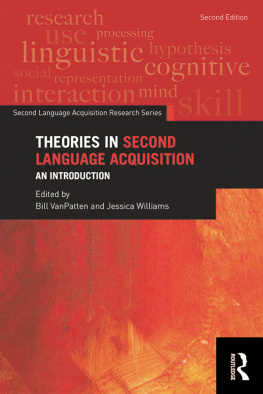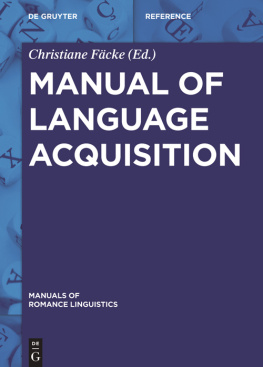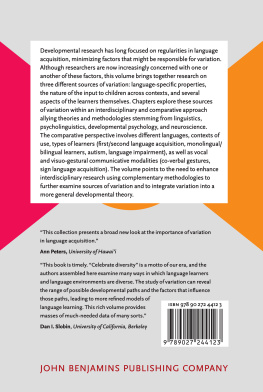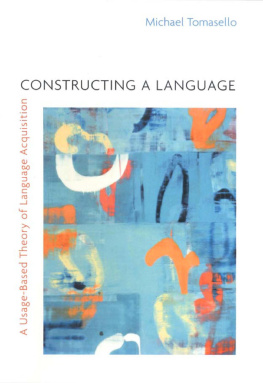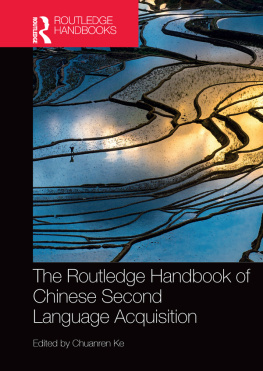Jessica Williams - Theories in second language acquisition: an introduction
Here you can read online Jessica Williams - Theories in second language acquisition: an introduction full text of the book (entire story) in english for free. Download pdf and epub, get meaning, cover and reviews about this ebook. year: 2015, publisher: Routledge, genre: Children. Description of the work, (preface) as well as reviews are available. Best literature library LitArk.com created for fans of good reading and offers a wide selection of genres:
Romance novel
Science fiction
Adventure
Detective
Science
History
Home and family
Prose
Art
Politics
Computer
Non-fiction
Religion
Business
Children
Humor
Choose a favorite category and find really read worthwhile books. Enjoy immersion in the world of imagination, feel the emotions of the characters or learn something new for yourself, make an fascinating discovery.
- Book:Theories in second language acquisition: an introduction
- Author:
- Publisher:Routledge
- Genre:
- Year:2015
- Rating:4 / 5
- Favourites:Add to favourites
- Your mark:
- 80
- 1
- 2
- 3
- 4
- 5
Theories in second language acquisition: an introduction: summary, description and annotation
We offer to read an annotation, description, summary or preface (depends on what the author of the book "Theories in second language acquisition: an introduction" wrote himself). If you haven't found the necessary information about the book — write in the comments, we will try to find it.
Theories in second language acquisition: an introduction — read online for free the complete book (whole text) full work
Below is the text of the book, divided by pages. System saving the place of the last page read, allows you to conveniently read the book "Theories in second language acquisition: an introduction" online for free, without having to search again every time where you left off. Put a bookmark, and you can go to the page where you finished reading at any time.
Font size:
Interval:
Bookmark:

The second edition of the best-selling Theories in Second Language Acquisition builds on the strengths of the first edition by surveying the major theories currently used in second language acquisition (SLA) research, serving as an ideal introductory text for undergraduate and graduate students in SLA and language teaching. Each chapter focuses on a single theory, written by a leading scholar in the field in an easy-to-follow stylea basic foundational description of the theory, relevant data or research models used with this theory, common misunderstandings, and a sample study from the field to show the theory in practice. This text is designed to provide a consistent and coherent presentation for those new to the field who seek basic understanding of theories that underlie contemporary SLA research but will also be useful to researchers as a quick guide to theoretical work outside their respective domains.
Bill VanPatten is professor of Spanish and second language studies at Michigan State University.
Jessica Williams is professor of linguisics at the University of Illinois at Chicago.
Susan M. Gass and Alison Mackey, Editors
Monographs on Theoretical Issues:
Schachter/Gass Second Language Classroom Research: Issues and Opportunities (1996)
Birdsong Second Language Acquisition and the Critical Period Hypotheses (1999)
Ohta Second Language Acquisition Processes in the Classroom: Learning Japanese (2001)
Major Foreign Accent: Ontogeny and Phylogeny of Second Language Phonology (2001)
VanPatten Processing Instruction: Theory, Research, and Commentary (2003)
VanPatten/Williams/Rott/Overstreet Form-Meaning Connections in Second Language Acquisition (2004)
Bardovi-Harlig/Hartford Interlanguage Pragmatics: Exploring Institutional Talk (2005)
Drnyei The Psychology of the Language Learner: Individual Differences in Second Language Acquisition (2005)
Long Problems in SLA (2007)
VanPatten/Williams Theories in Second Language Acquisition (2007)
Ortega/Byrnes The Longitudinal Study of Advanced L2 Capacities (2008)
Liceras/Zobl/Goodluck The Role of Formal Features in Second Language Acquisition (2008)
Philp/Adams/Iwashita Peer Interaction and Second Language Learning (2013)
VanPatten/Williams Theories in Second Language Acquisition, Second Edition (2014)
Monographs on Research Methodology:
Tarone/Gass/Cohen Research Methodology in Second Language Acquisition (1994)
Yule Referential Communication Tasks (1997)
Gass/Mackey Stimulated Recall Methodology in Second Language Research (2000)
Markee Conversation Analysis (2000)
Gass/Mackey Data Elicitation for Second and Foreign Language Research (2007)
Duff Case Study Research in Applied Linguistics (2007)
McDonough/Trofimovich Using Priming Methods in Second Language Research (2008)
Larson-Hall A Guide to Doing Statistics in Second Language Research Using SPSS (2009)
Drnyei/Taguchi Questionnaires in Second Language Research: Construction, Administration, and Processing, 2nd Edition (2009)
Bowles The Think-Aloud Controversy in Second Language Research (2010)
Jiang Conducting Reaction Time Research for Second Language Studies (2011)
Barkhuizen/Benson/Chik Narrative Inquiry in Language Teaching and Learning Research (2013)
Jegerski/VanPatten Research Methods in Second Language Psycholinguistics (2013)
Of Related Interest:
Gass Input, Interaction, and the Second Language Learner (1997)
Gass/Sorace/Selinker Second Language Learning Data Analysis, Second Edition (1998)
Mackey/Gass Second Language Research: Methodology and Design (2005)
Gass/Selinker Second Language Acquisition: An Introductory Course, Third Edition (2008)
This edition first published 2015
by Routledge
711 Third Avenue, New York, NY 10017
and by Routledge
2 Park Square, Milton Park, Abingdon, Oxon, OX14 4RN
Routledge is an imprint of the Taylor & Francis Group, an informa business
2015 Taylor & Francis
The right of Bill VanPatten and Jessica Williams to be identified as the authors of the editorial material, and as the authors for their individual chapters, has been asserted in accordance with sections 77 and 78 of the Copyright, Designs and Patents Act 1988.
All rights reserved. No part of this book may be reprinted or reproduced or utilized in any form or by any electronic, mechanical, or other means, now known or hereafter invented, including photocopying and recording, or in any information storage or retrieval system, without permission in writing from the publishers.
Trademark notice: Product or corporate names may be trademarks or registered trademarks, and are used only for identification and explanation without intent to infringe.
[First edition published by Lawrence Erlbaum Associates, Inc. 2007]
Library of Congress Cataloging-in-Publication Data
Theories in second language acquisition : an introduction / Bill VanPatten
and Jessica Williams, Michigan State University and University of Illinois
at Chicago. Second Edition.
pages cm. (Second Language Acquisition Research Series)
Includes bibliographical references and index.
1. Second language acquisition. I. VanPatten, Bill, editor. II. Williams,
Jessica, 1957 editor.
P118.2.T45 2015
418.0071dc23
2014018009
ISBN: 978-0-415-82420-0 (hbk)
ISBN: 978-0-415-82421-7 (pbk)
ISBN: 978-0-203-62894-2 (ebk)
Typeset in Bembo
by Apex CoVantage, LLC
Bill VanPatten and Jessica Williams
Bill VanPatten and Jessica Williams
Lydia White
Kathleen Bardovi-Harlig
Nick C. Ellis and Stefanie Wulff
Robert DeKeyser
Bill VanPatten
Michael T. Ullman
Manfred Pienemann and Anke Lenzing
Susan M. Gass and Alison Mackey
James P. Lantolf, Steven L. Thorne, and Matthew E. Poehner
Diane Larsen-Freeman
Lourdes Ortega
This book focuses on a number of contemporary mainstream theories in second language acquisition (SLA) research that have generated attention among scholars. For several decades, the field of SLA has struggled with the nature of theories, what they are, and what would be an acceptable theory of SLA. Indeed, the present volume draws on one particular publication by Michael Long in a special issue of the TESOL Quarterly from 1990 devoted to the construction of a theory in SLA. In that article, Long discussed the nature of what a theory needs to be in SLA and also summarized the research to establish the least a theory of SLA needs to explain. We borrow from Longs article in our first chapter to outline the challenges to contemporary theories and list 10 observations that need to be accounted for on theoretical grounds.
One might ask why there are so many competing theories in SLA at this point. Why isnt there just one theory that accounts for SLA? What is it about SLA that invites a diffusion of theoretical perspectives? To understand this, one might consider the parable about the four blind men and the elephant. These sightless men chance upon a pachyderm for the first time and one, holding its tail, says, Ah! The elephant is very much like a rope. The second one has wrapped his arms around a giant leg and says, Ah! The elephant is like a tree. The third has been feeling alongside the elephants massive body and says, Ah! The elephant is very much like a wall. The fourth, having seized the trunk, cries out, Ah! The elephant is very much like a snake. For us, SLA is a big elephant that researchers can easily look at from different perspectives. SLA is, after all, an incredibly complex set of processes, and if you have been introduced to the field via any of the excellent overviews of SLA, this most likely is your conclusion. Thus, researchers have grabbed onto different parts of the elephant as a means of coming to grips with the complex phenomenon. This does not mean, however, that researchers and scholars have gone poking around SLA blindly and without thought; the present chapters should convince you otherwise. Unlike the blind men of our fable, researchers grasp that to understand the whole of SLA, they may need to concentrate on the smaller parts first. In the end, we may even need multiple complementary theories to account for different observed phenomena of SLA. As you complete the readings in your book, you might ask yourself, Just what part of the elephant is each theory examining?
Font size:
Interval:
Bookmark:
Similar books «Theories in second language acquisition: an introduction»
Look at similar books to Theories in second language acquisition: an introduction. We have selected literature similar in name and meaning in the hope of providing readers with more options to find new, interesting, not yet read works.
Discussion, reviews of the book Theories in second language acquisition: an introduction and just readers' own opinions. Leave your comments, write what you think about the work, its meaning or the main characters. Specify what exactly you liked and what you didn't like, and why you think so.

